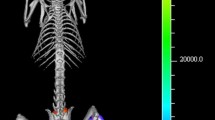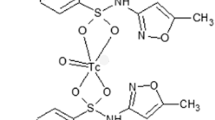Abstract
To establish a routine workflow for in vivo magnetic resonance imaging (MRI) of mice infected with bacterial biosafety level 2 pathogens and to generate a mouse model for systemic infection with Staphylococcus aureus suitable for monitoring by MRI. A self-contained acrylic glass animal bed complying with biosafety level 2 requirements was constructed. After intravenous infection with 105 colony-forming units (CFU) (n = 3), 106 CFU (n = 11) or 107 CFU (n = 6) of S. aureus strain Newman, female Balb/c mice were whole-body scanned by 7T MRI. Abdominal infections such as abscesses were visualized using a standard T2-weighted scan. Infection monitoring was performed for each animal by measurements at 1, 3, and 7 days after infection. Intravenous pathogen application led to a dose-dependent decrease in survival probability (p = 0.03). In the group with the highest infectious dose the 7-day survival rate was 33 %. An intermediate S. aureus dose showed a survival rate of 80 %, whereas at the lowest infection dose, none of the animals died. All animals with the highest infection dose exhibited hepatic abscesses 4 days after inoculation, 80 % developed renal abscesses on the 3rd day. Mice obtaining the intermediate S. aureus load reached a plateau at day 4 with 72 % liver and 60 % renal abscess probability. No abscesses were observed in other abdominal organs at any time point. The implemented experimental setup provides a suitable and reliable in vivo MRI method to study murine abdominal infection models using BSL-2 pathogen. Systemic Staphylococcus aureus infection leads to a dose-dependent development of hepatic and renal abscesses.


Similar content being viewed by others
References
Wall SD, Fisher MR, Amparo EG, Hricak H, Higgins CB (1985) Magnetic resonance imaging in the evaluation of abscesses. AJR Am J Roentgenol 144(6):1217–1221. doi:10.2214/ajr.144.6.1217
Paajanen H, Brasch RC, Schmiedl U, Ogan M (1987) Magnetic resonance imaging of local soft-tissue inflammation using gadolinium-DTPA. Acta Radiol 28(1):79–83
El-Khoury GY, Brandser EA, Kathol MH, Tearse DS, Callaghan JJ (1996) Imaging of muscle injuries. Skeletal Radiol 25(1):3–11
Marzola P, Nicolato E, Di Modugno E, Cristofori P, Lanzoni A, Ladel CH, Sbarbati A (1999) Comparison between MRI, microbiology and histology in evaluation of antibiotics in a murine model of thigh infection. Magn Reson Mater Phys 9(1–2):21–28
Chandnani VP, Beltran J, Morris CS, Khalil SN, Mueller CF, Burk JM, Bennett WF, Shaffer PB, Vasila MS, Reese J et al (1990) Acute experimental osteomyelitis and abscesses: detection with MR imaging versus CT. Radiology 174(1):233–236. doi:10.1148/radiology.174.1.2294554
Ring J, Hoerr V, Tuchscherr L, Kuhlmann MT, Loffler B, Faber C (2014) MRI visualization of Staphylococcus aureus-induced infective endocarditis in mice. PLoS One 9(9):e107179. doi:10.1371/journal.pone.0107179
Lowy FD (1998) Staphylococcus aureus infections. N Engl J Med 339(8):520–532. doi:10.1056/NEJM199808203390806
Chambers HF (2005) Community-associated MRSA--resistance and virulence converge. N Engl J Med 352(14):1485–1487. doi:10.1056/NEJMe058023
Doi K, Leelahavanichkul A, Yuen PS, Star RA (2009) Animal models of sepsis and sepsis-induced kidney injury. J Clin Invest 119(10):2868–2878. doi:10.1172/JCI39421
Horst SA, Hoerr V, Beineke A, Kreis C, Tuchscherr L, Kalinka J, Lehne S, Schleicher I, Kohler G, Fuchs T, Raschke MJ, Rohde M, Peters G, Faber C, Loffler B, Medina E (2012) A novel mouse model of Staphylococcus aureus chronic osteomyelitis that closely mimics the human infection an integrated view of disease pathogenesis. Am J Pathol 181(4):1206–1214. doi:10.1016/j.ajpath.2012.07.005
Rudin M, Beckmann N, Mir A, Sauter A (1995) In-vivo magnetic-resonance-imaging and spectroscopy in pharmacological research—assessment of morphological, physiological and metabolic effects of drugs. Eur J Pharm Sci 3(5):255–264. doi:10.1016/0928-0987(95)00012-3
Ruiz-Cabello J, Carrero-Gonzalez B, Aviles P, Santisteban C, Mendez RJ, Ferreiros J, Malpica N, Santos A, Gargallo-Viola D, Regadera J (1999) Magnetic resonance imaging in the evaluation of inflammatory lesions in muscular and soft tissues: an experimental infection model induced by Candida albicans. Magn Reson Imaging 17(9):1327–1334
Rauch S, DeDent AC, Kim HK, Bubeck Wardenburg J, Missiakas DM, Schneewind O (2012) Abscess formation and alpha-hemolysin induced toxicity in a mouse model of Staphylococcus aureus peritoneal infection. Infect Immun 80(10):3721–3732. doi:10.1128/IAI.00442-12
Acknowledgements
The authors thank A. Kohler for excellent technical assistance and Dr Katrin Breitbach for assistance during mice infection experiments.
Author information
Authors and Affiliations
Corresponding author
Ethics declarations
Conflicts of interest
The authors declare that they have no conflicts of interests.
Financial support
This work was supported by the German Federal Ministry of Education and Research (BMBF), grant no. 0314107.
Statement on the welfare of animals
All applicable international, national, and institutional guidelines for the care and use of animals were followed. All procedures performed in studies involving animals were in accordance with the ethical standards of the institution or practice at which the studies were conducted.
Electronic supplementary material
Below is the link to the electronic supplementary material.
Supplementary Fig. 1
Kaplan–Meier survival curves among female Balb/c mice after intravenous infection with 105 CFU (n = 3), 106 CFU (n = 11), or 107 CFU (n = 6) of Staphylococcus aureus strain Newman. (JPG 67 kb)
Supplementary Fig. 2
Kaplan–Meier curves of the combined cumulative probability of hepatic and renal abscesses among female Balb/c mice after intravenous infection with 106 CFU (n = 11) or 107 CFU (n = 6) of Staphylococcus aureus strain Newman. (JPG 68 kb)
Rights and permissions
About this article
Cite this article
Kromrey, M.L., Göhler, A., Friedrich, N. et al. Monitoring of abdominal Staphylococcus aureus infection using magnetic resonance imaging: a murine animal model for hepatic and renal abscesses. Eur J Clin Microbiol Infect Dis 36, 373–378 (2017). https://doi.org/10.1007/s10096-016-2811-9
Received:
Accepted:
Published:
Issue Date:
DOI: https://doi.org/10.1007/s10096-016-2811-9




